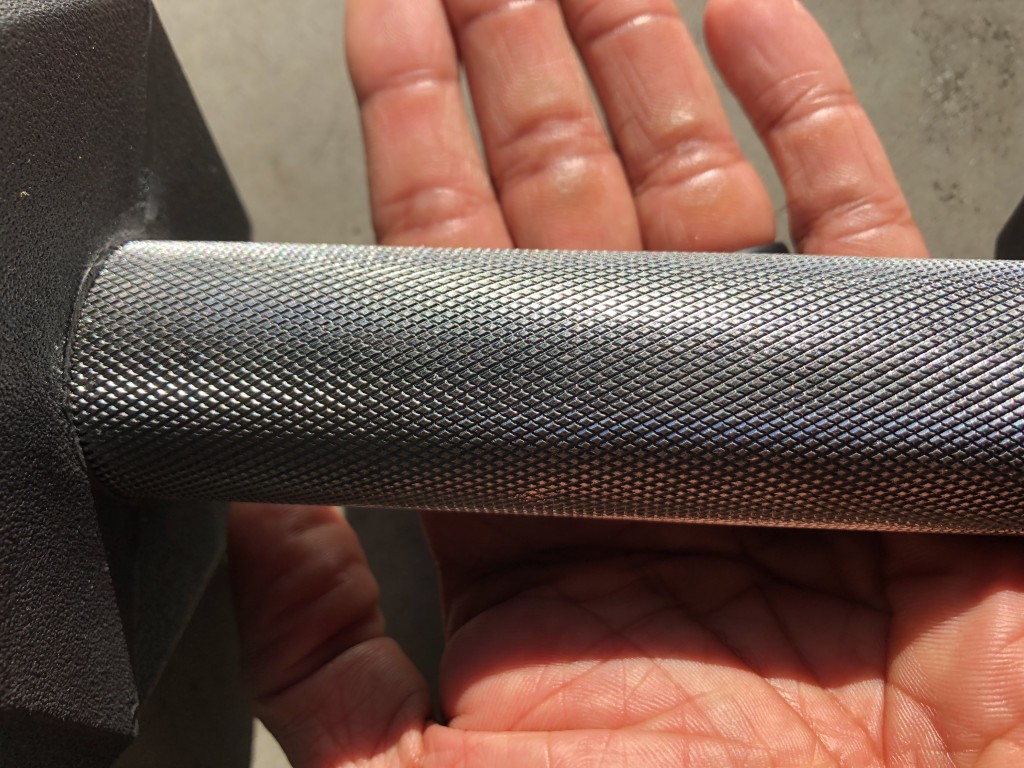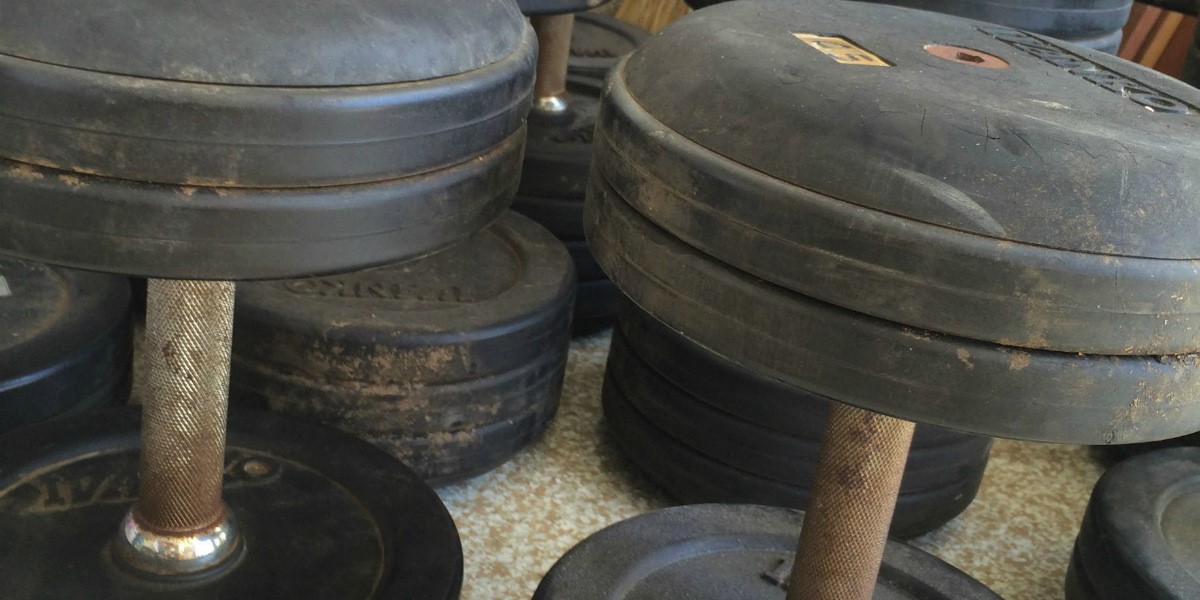Table of Contents
First Off: Go With Rubber
Soooo many dumbbells to choose from! How do you know where you should be buying them to get the best deal, and what kind is right for your needs?
I recommend going at least one step above the cheapest quality dumbbells, opting for rubber-coated dumbbells instead of the cheaper cast iron hex dumbbells.
Note: All rubber dumbbells are rubber coated with a thin layer and are never solid rubber all the way down to the core. Solid rubber does not weigh enough, which would result in a dumbbell being twice as large as the versions with an iron core. The only all-rubber weights you will find anywhere are bumper plates, which are just another plate for olympic bars but will absorb the impact from being dropped on concrete from overhead during the olympic lifts (the snatch and the clean-and-jerk).
Rubber coated dumbbells will last longer with no risk of chipping, while the paint on regular hex dumbbells could chip or flake off over time. Rubber also reduces noise, and there will be less risk of damage to the dumbbells, floor, or other things if you should drop them.
We did a review of the Rep Fitness rubber dumbbells, which are some of the best rubber dumbbells on the market today. Virtually no rubber odor, and a nice thick handle with good knurling.

At Adamant Barbell I have sold tons and tons of the Troy 12-sided rubber dumbbells. Out of all the brands and models of rubber dumbbells I’ve sold, those are consistently the most popular. They feel great, have nice smooth heads, and they fit well on any dumbbell rack, whether the rack is a flat tray or a commercial gym style rack with dedicated saddles for each dumbbell.
If You’re Swimming in Cash
The next step up would be urethane dumbbells, which look very much like rubber but are a different animal on the molecular level.
First, urethane does not degrade over time like rubber can. Over the years, rubber can develop more of a “rough” look.
Some of this is also due to the better abrasion resistance of urethane. Urethane doesn’t scratch or scuff up the same way rubber can, so the surface can look pretty new even with a lot of use.
In extremes of temperature or from exposure to sunlight through a window, urethane wins big. It won’t crack, while rubber can potentially start cracking, leading to peeling.
Don’t let me scare you away from rubber, though. What I’m describing here are the worst things that can possibly happen, not what is typical. The big chain gyms with oodles of money to spend on equipment have been going with urethane dumbbells for many years now, while for home users it’s perfectly reasonable to go with rubber and to plan on keeping them for decades. A home gym, or small commercial gym, doesn’t see anywhere near the volume of use and abuse that a 24/7 commercial gym does.
Brand Matters
Get a good brand. Cheaper rubber dumbbells have problems:
- The rubber may start peeling or cracking, because it’s a cheap rubber formulation or isn’t applied thick enough.
- The heads may break slightly loose from the handle if you drop them and stay together but forever be wobbly because of the lousy welding job.
- They may arrive with rust spots on the handles, or banged up, because of poor packaging.
- The light knurling on the handle may leave the handle too slippery because it was so cheaply pressed by the lathe to save wear on the lathe bit.
- They will stink if they are made from recycled rubber.
Good brands of rubber dumbbells to pick from include:
These companies are all known for making high quality weights. You can’t always tell online how high quality something like a dumbbell is, but when you buy a good brand you will be happy. No nasty surprises or dealing with a company who doesn’t want to fix the situation because they’re all about cutting corners and saving money.
Recycled Rubber Dumbbells
Even good brands have some models of recycled rubber dumbbells, which are cheaper and lower quality than their premium ones.
The issue with these is the odor. It’s like the smell of tires. On the road, tires are fine, but in a small home gym the odor will fill the room. Anyone very sensitive to odors will be able to smell them for a month or longer even after they have been unpackaged and have time to air out.
If I remember right, the odor of recycled rubber dumbbells really isn’t toxic, but it smells bad, apparently. I barely have any sense of smell, so I’m just going by what I’ve been told from various sources. The odor has to do with the gas created in the rubber for a while after it has been applied, and it just needs some air flow for a while until it can finish off-gassing. It doesn’t get that kind of air flow packaged up in a box. It generally stays in that same box from the time it was produced in China until it gets to your door. Manufacturers in the US just inspect a small portion of them and leave the rest in the original boxes.
If you have patience with the odor, these can be just fine! If you’ve got clientele to serve, you would best avoid giving a bad first impression, even if the odor will be gone after a while.
While these might be just fine in construction, such as having a very good method of attaching the heads to the handle where they won’t easily get knocked loose and wobble, or having a good rubber coating for what it is.
Tip: Clean Them When You Get Them!
Some of the odor complaints people have about new dumbbells has to do with the oil that they are coated in from the factory to protect them from rust during storage and transport, not the rubber itself. So don’t freak out if your high end rubber dumbbells stink out of the box. The rubber itself might be odorless.
You have to clean off the oil. We have an article about cleaning dumbbells and other equipment.
To sum it up simply, get a cloth wet with a very light solution of dish soap and water and wipe down the dumbbells, then be sure to dry them off good with another cloth. If they still stink, do it again. Don’t get too much soap on them and make them all slippery.
Pricing
As of writing there are issues with China tariffs. Companies will start sourcing from other countries, but regardless, prices go up over the years even with no trade issues happening, due to the value of the dollar slowly decreasing.
Recycled rubber dumbbells can be bought new for somewhere around $1.25-$2.00 per pound.
Non-recycled rubber dumbbells are more like $2.50 per pound.
The price of urethane varies, but the urethane coating is so expensive that often the price per pound is a lot higher on the lighter weights because there’s a higher proportion of urethane vs iron and steel. Rubber and iron dumbbells are usually priced per pound. Look at the price of the heaviest and lightest weight you’ll get when you’re calculating the per-pound price of urethane dumbbells to see if this applies, so you don’t skip over a decent deal just because the lighter weights look expensive.
As is usually the case, the lowest prices per pound of any heavy weights like this sometimes end up being about the same as others once you factor in shipping charges vs free shipping. It’s a game all the retailers play, figuring out whether customers would rather have free shipping or pay less with an estimate of the actual shipping costs.

